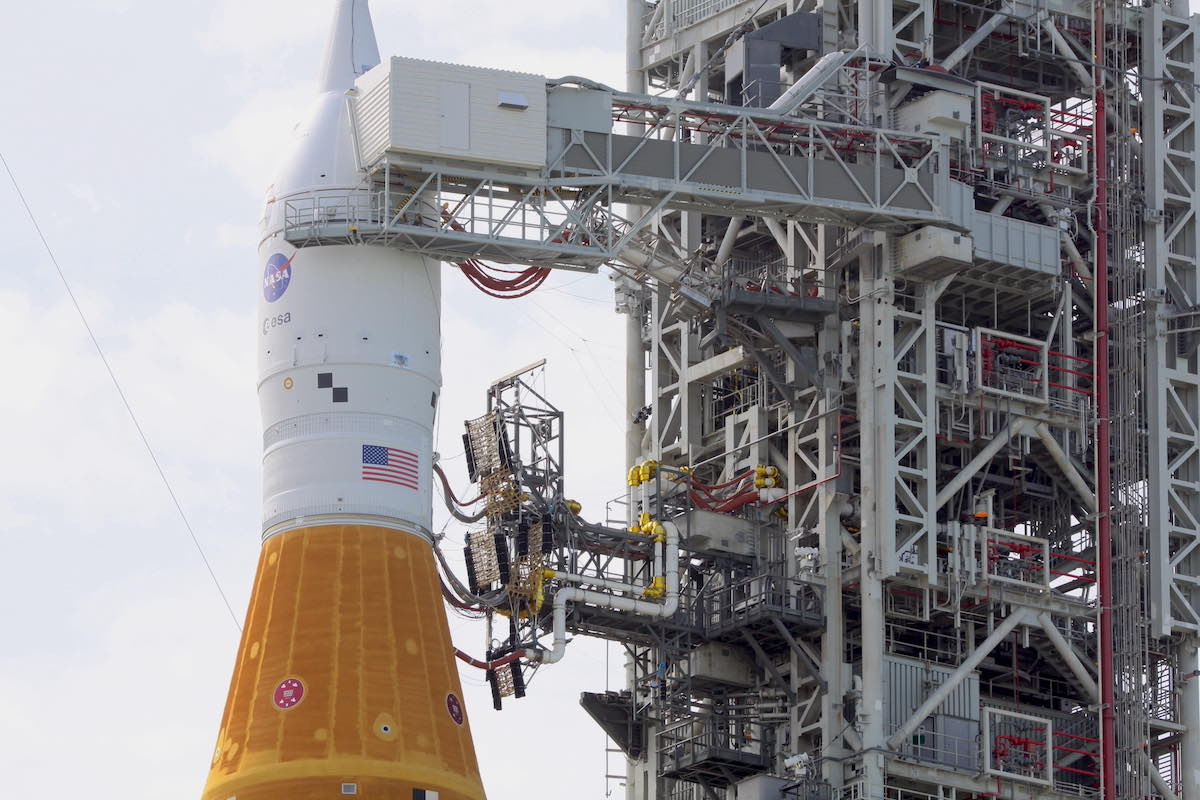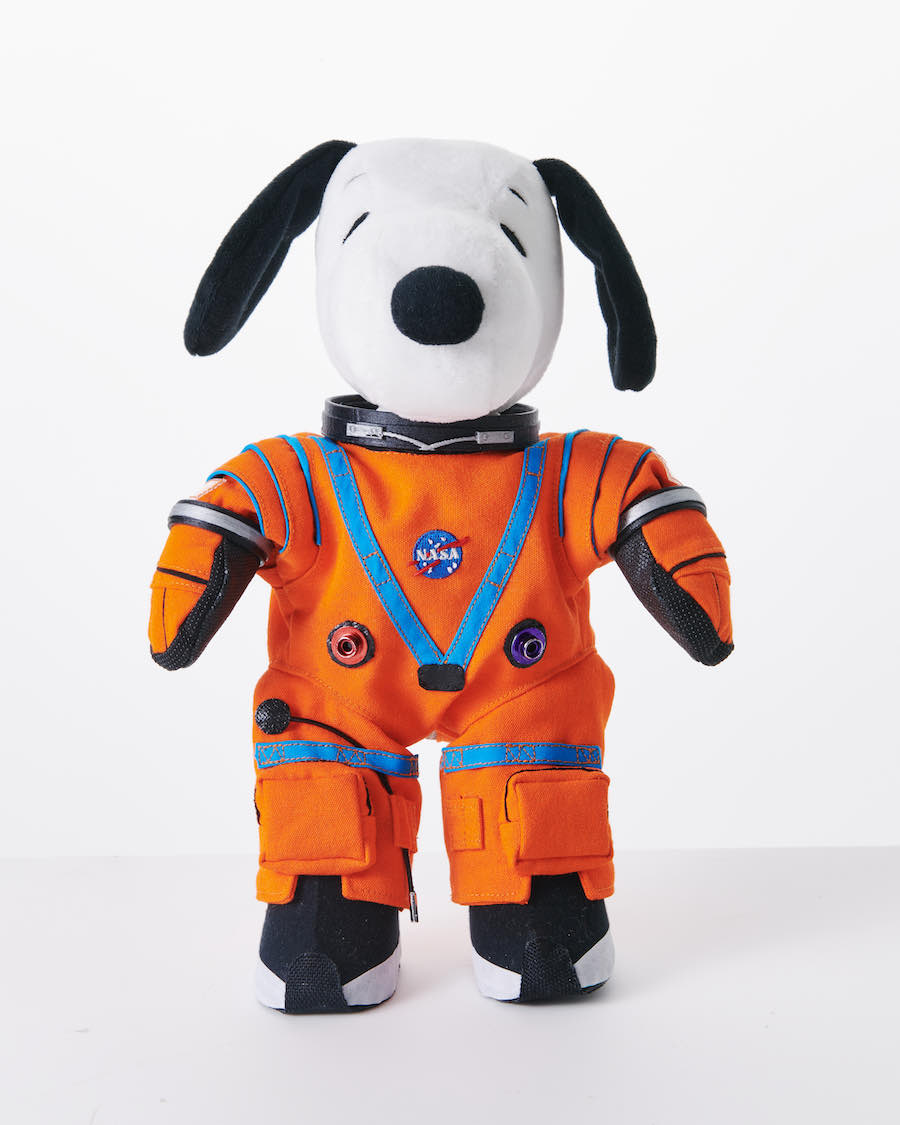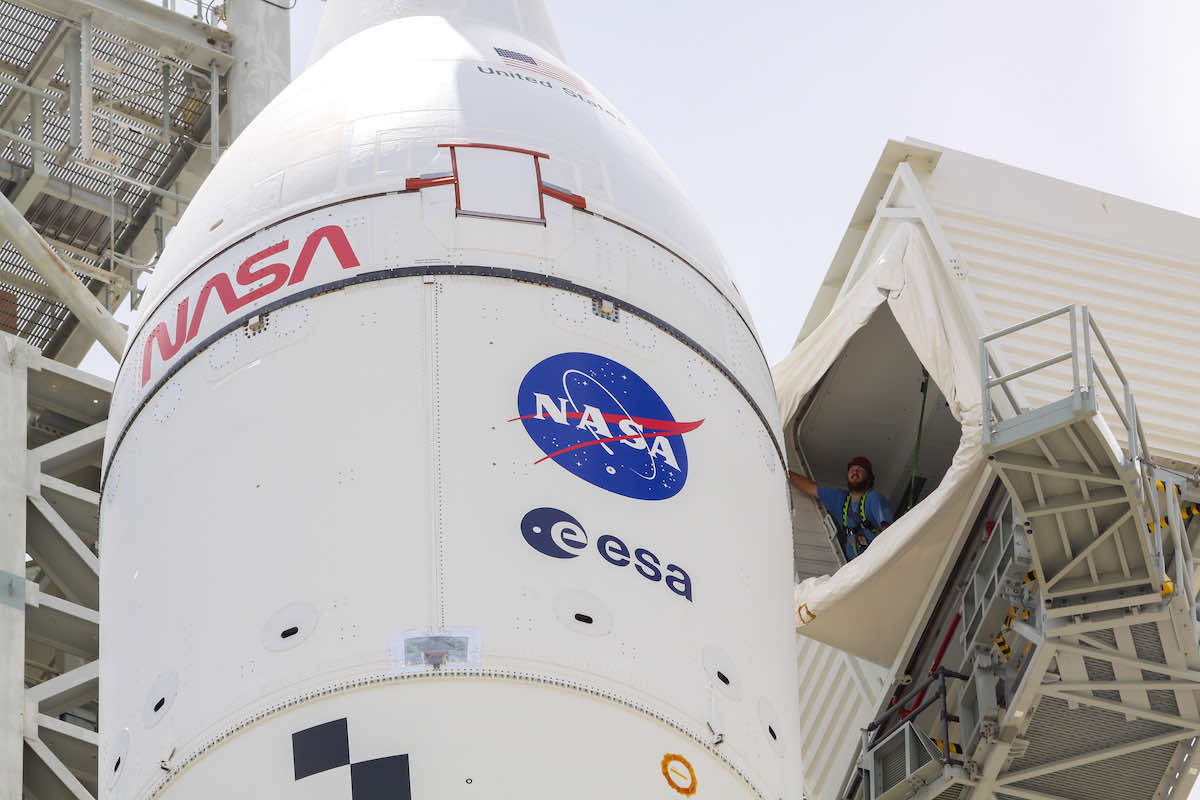
The Orion crew module hatch was closed for launch Thursday morning after technicians at pad 39B completed final closeouts and outfitting inside the spacecraft before liftoff next week on the unpiloted Artemis 1 test flight around the moon.
The first official launch weather forecast for the Artemis 1 mission was also released Thursday. Forecasters at the U.S. Space Force’s 45th Weather Squadron predict a 70% chance for favorable conditions during the two-hour Artemis 1 launch window opening at 8:33 a.m. EDT (1233 GMT) Monday.
After elevated changes of thunderstorms over the next few days along Florida’s Space Coast, a change in the weather patten is expected Sunday, resulting in decreased shower and storm coverage.
“This flow regime will remain in place for the opening of the initial launch window Monday morning,” forecasters wrote in the outlook issued Thursday. “While the overall lightning threat seems low, this onshore flow regime will promote scattered showers across the Atlantic waters through the launch window. As a result, the primary weather concerns for a Monday morning attempt will be the cumulus cloud rule, surface electric fields rule, and the flight through precipitation constraint.
The hatch closure early on the Orion spacecraft Thursday was another major milestone as NASA prepares to launch the huge 322-foot-tall (96-meter) Space Launch System rocket for the first time on a precursor mission for future astronaut flights to the moon.
The side hatch to the crew module was closed Thursday morning. An outer hatch on the aeroshell surrounding the Orion spacecraft for launch was to be closed for flight Thursday evening.
The two-day launch countdown begins Saturday.
“The vehicle is in very good shape heading into launch countdown on Saturday morning,” said Cliff Lanham, NASA’s Artemis 1 flow director at the Kennedy Space Center.
“The boosters are ready for launch countdown,” Lanham said. “The core stage is ready for countdown The ICPS (upper stage) is ready for countdown. So the vehicle, as a whole, is ready.
“On Orion, we spent a good deal of yesterday doing some internal inspections, finishing up the zero-g simulator, getting that installed,” Lanham said Thursday. The zero gravity indicator riding on the Orion capsule is a plush Snoopy toy wearing an orange spacesuit, a choice that honors the iconic character’s history as a mascot for NASA human spaceflight programs dating back to the 1960s.
Three mannequins were previously loaded into the Orion crew capsule for the ride around the moon on Artemis 1. They will gather data on the vibrations, accelerations, and radiation environment throughout the test flight.

Other activities at the launch pad in Florida Thursday included configuring fire suppression system around the flame hole, which will see most of the rocket’s super-hot exhaust at liftoff. Lanham said the engine service platform underneath the rocket has been lowered and was expected to move down the ramp at pad 39B into position for launch.
The flame deflectors are also in place at pad 39B. The moon rocket rolled out to the launch facility from the Vehicle Assembly Building last week.
“They’ve been going around the clock out at the pad,” Lanham said.
The Orion spacecraft on top of the SLS moon rocket is not carrying a crew on Artemis 1. But the behemoth launcher and Orion capsule are designed to fly astronauts on the next mission, known as Artemis 2, scheduled for launch on a trip around the moon in 2024. Future Artemis flights will incorporate a human-rated lunar lander developed by SpaceX to ferry crews to and from the lunar surface.
The Artemis program is NASA’s first attempt to return humans to the moon since the Apollo program’s last lunar flight 50 years ago. Twelve men walked on the moon in the Apollo program from 1969 through 1972.
In Greek mythology, Artemis is the twin sister of Apollo. That’s a fitting name because NASA says the Artemis program will carry the first woman and first person of color to the moon.
The Orion moon ship consists of two parts: A pressurized crew module and cockpit built by Lockheed Martin, and a service built by Airbus that provides power and propulsion to the spacecraft.

Most of the hands-on work on the SLS moon rocket has been completed. Teams loaded hydrazine fuel into the rocket’s solid-fueled booster hydraulic steering units earlier this week. The Northrop Grumman-made boosters will provide most of the 8.8 million pounds of thrust in the first two minutes of the flight to drive the SLS moon rocket off the pad.
The Space Launch System is the most powerful rocket ever developed by NASA, and one of the largest rockets ever built. Its engines and boosters will provide about 15% more thrust than the Saturn 5 moon rocket from the Apollo program, but the Space Launch System — in its current configuration — is about 40 feet shorter than the Saturn 5.
The SLS thrust level falls short of the Soviet Union’s N1 moon rocket and SpaceX’s planned reusable Starship launcher. But the N1 failed on all of its test flights. SpaceX’s Super Heavy booster and Starship rocket program is nearing its first orbital test flight, but the SLS moon rocket appears ready to launch first.
The SLS moon rocket’s Boeing-built core stage will fire its four hydrogen-fueled Aerojet Rocketdyne RS-25 engines about eight minutes, then an upper stage produced by United Launch Alliance — called the interim cryogenic propulsion system, or ICPS — will fire two times to send the Orion spacecraft toward the moon. The Orion capsule will maneuver into a distant retrograde orbit around the moon for checkouts ahead of future crew missions.
Assuming the launch occurs Aug. 29, the Orion spacecraft would return to Earth for a splashdown in the Pacific Ocean off the coast of California on Oct. 10.
NASA has backup launch opportunities available Sept. 2 and Sept. 5. If the mission isn’t off the ground by Sept. 6, Artemis 1 will face a weeks-long delay to allow time for the rocket to return to the Vehicle Assembly Building for servicing.
Email the author.
Follow Stephen Clark on Twitter: @StephenClark1.
